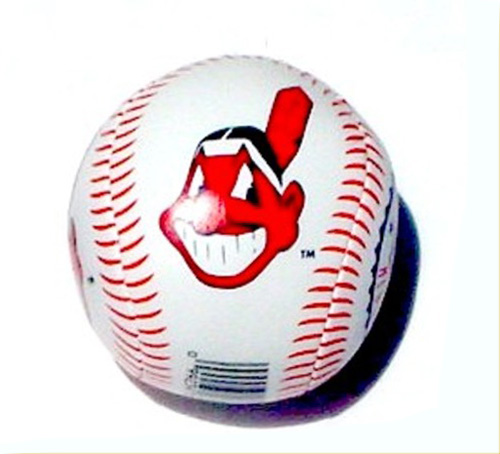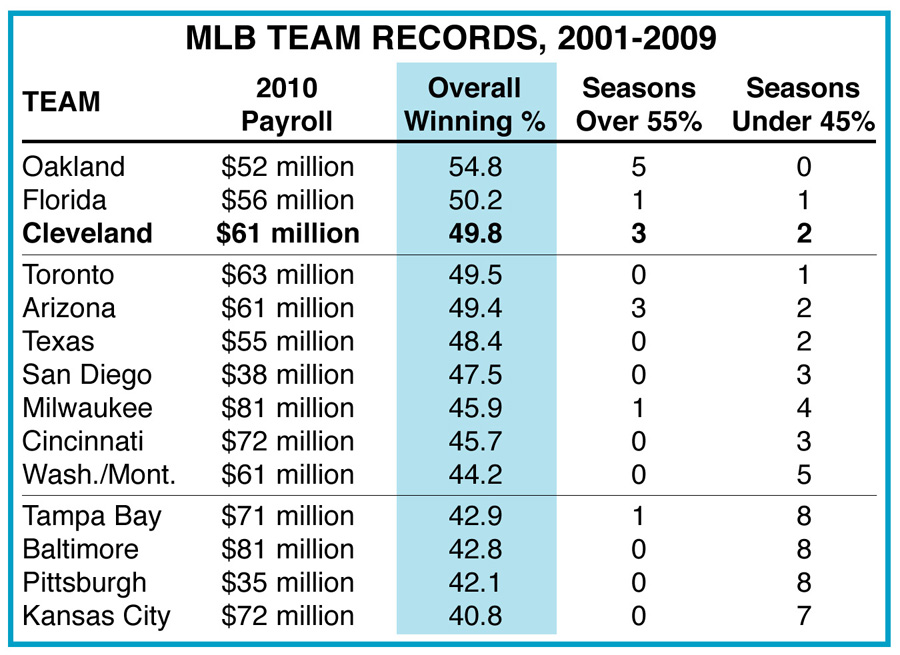 Indians Archive
Indians Archive  Not All Shappy's Fault
Not All Shappy's Fault
 Zero trips to the World Series in nine seasons. One crummy trip to the ALCS. A team that has fallen from 455 straight sell-outs to last in all of major-league baseball in home attendance.
Zero trips to the World Series in nine seasons. One crummy trip to the ALCS. A team that has fallen from 455 straight sell-outs to last in all of major-league baseball in home attendance.
Travis Hafner making $11 million for hitting .267 and spending half the season on the bench. Cy Young winner CC Sabathia pitching for the Yankees (13-5, 3.19 ERA). Cy Young winner Cliff Lee pitching for the Texas Rangers (9-5, 2.51 ERA). All-Star Victor Martinez catching for the Red Sox (.284 BA, .801 OPS).
These are the legacies that Mark Shapiro will leave with, upon his elevation from general manager to president of the Cleveland Indians at the end of the season. So it’s not difficult to understand the loud, continuous public outcry for Shapiro’s head on a platter (rather than, horror of horrors, a promotion)!
Yet, if you bother to compare his team’s performance with that of other teams in the same general financial position, it doesn’t take much analysis to come to the conclusion that Shapiro actually has done fairly well. Comparatively speaking, of course -- if that makes a difference to championship-starved Cleveland sports fans. (Hint: it really doesn’t.)
For the purposes of this article, we’ve taken the teams with the 14 lowest payrolls and looked back at their on-field success over the past nine seasons (not including this one). The data is reflected in the accompanying table.
As any baseball fan realizes, it takes an annual player payroll of $100 million or more to be a consistent contender in MLB -- and even that is no guarantee. But on occasion, even a mid-level team (like Tampa Bay, San Diego and Cincinnati this season) can be an exciting contender in any one given season. As the Indians were in 2007.

Of the 14 teams compared here, just four have made it to the World Series since 2000. Two -- Florida and Arizona -- became world champions, both of them beating the Yankees (Florida 4-2 in 2003 and Arizona 4-3 in 2001). Tampa Bay lost to Philadelphia 4-1 in 2008, while Houston was whitewashed by the White Sox in 2005.
Just two of the 14 teams have won more games than they’ve lost during the years 2001 to 2009. However, the Indians have actually done quite well among their 13 peers, ranking third with a 49.8 winning percentage. Only Oakland and Florida have had better cumulative records than the Tribe.
For the purposes of separating contenders from pretenders in the table, we’ve used winning percentages of 55 and 45 as cut-off points. Any team with a winning percentage of 55 or better during any one season can challenge for a pennant. However, any team with a winning percentage of less than 45 is usually doomed to not even compete for a playoff berth during any one season. And most are out of contention by June.
More than anything else, the numbers are a testament to just how difficult it is for a team with a middle to lower payroll structure to achieve any sort of consistency. Of the 14 teams, only Oakland has been able to turn the trick. The A's have an overall nine-year winning percentage of 54.8 and five seasons with records of better than 55 percent (that’s 90 victories per).
Yet our beloved Wahoos have had three seasons with a winning percentage of more than 55 percent. That’s more success than 11 of the teams listed here.
Things could be much worse for Tribe fans. Much worse. Take, for instance, the Baltimore Orioles and Kansas City Royals. Both have player payrolls in the same general range as the Indians, but they’ve had eight and seven seasons, respectively, with records of less than .450. Pittsburgh is in a class by itself with a paltry payroll of $35 million and no winning seasons in the last 20.
Despite the comparative success of the Tribe this century (when measured against other financially similar teams), the team has yet to win a pennant or a World Series. By and large -- especially recently when Shapiro didn’t have leftover players (and a budget) from the John Hart years -- the Indians haven’t been steady contenders in the American League Central Division, which is among the most balanced in all of Major League Baseball.
I’ve never been a Shapiro fan. Certainly, a lot comes from the Indians’ lackluster performance on his watch. Maybe some of it is jealousy; after all, he’s an Ivy Leaguer with a beautiful wife and a great pedigree. So sue me for being human.
Without being an apologist, though, and looking at the Indians’ situation vis à vis their competition and the payroll structure of MLB, you can’t lay all the blame in Shapiro’s lap. If he’s not been in a “no-win” situation with a mid-level team and the big-market MLB rules stacked against him, it’s at least been a “seldom-win” situation. And that’s exactly what he’s done: no better, no worse.
As Shapiro hands the general managership to Chris Antonetti and assumes the position of team president 60 games hence, we cannot rationally castigate him. But neither can we condone his performance. Over the past nine years, it would have taken a general-managerial batting average of something on the order of .750 for the Indians to remain in contention, season-in and season-out.
As with most things related to Cleveland professional sports, his tenure has been … well, unremarkable. Maybe Antonetti will have better luck. He’s got a talented but unproven young everyday lineup to work with, along with a pitching staff that could be anything from sucktastic to awesome.
Except for seeing what the all the new kiddies can do in the big time, the Indians’ 2010 season is already in the toilet. So let the countdown to the 2011 opener begin. And cross your fingers -- as usual.
- NBA Announces 2013-2014 Schedule
- Browns Ink Sharknado
- Sharknado A No-Show For Rookie Camp
- Trent Richardson Out Until Training Camp
- Browns Sign Brandon Jackson
- Carrasco Suspended Eight Games
- Browns Add to Wide Receiver Depth with David Nelson
- Browns Need to Learn from Past Draft Mistakes
- Browns Release Chris Gocong and Usama Young
- Browns Missing on Grimes Disappointing, But Not The End
The TCF Forums
- Chris Grant's first 3 drafts
Kingpin74 (Tuesday, January 21 2014 10:13 AM) - The 2014 Offseason Thread
googleeph2 (Tuesday, January 21 2014 9:36 AM) - 2015 Recruiting
furls (Tuesday, January 21 2014 6:57 AM) - Mike Brown
YahooFanChicago (Monday, January 20 2014 11:15 PM) - Movies coming out
HoodooMan (Monday, January 20 2014 9:34 PM) - 2014 Hoops Hockey Hijinx
jpd1224 (Monday, January 20 2014 4:44 PM) - 2014 Recruiting
jclvd_23 (Monday, January 20 2014 2:26 PM) - Wish List - #4 Pick
Hikohadon (Monday, January 20 2014 1:26 PM) - Official- Browns Coach Search/Rumors
OldDawg (Sunday, January 19 2014 6:48 PM) - #1 overall pick Anthony Bennett
TouchEmAllTime (Sunday, January 19 2014 1:28 PM)



